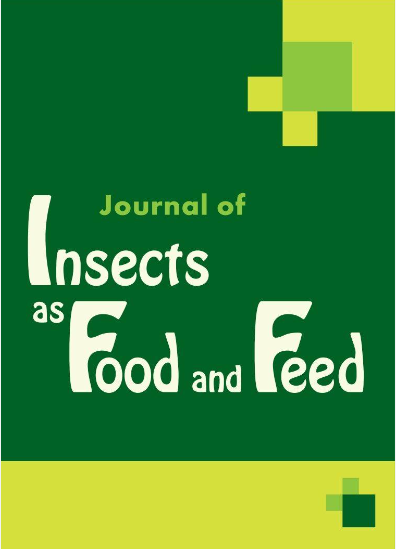确定饲养褐飞虱幼虫的最佳温度和宏量营养素平衡组合
IF 3.5
3区 农林科学
Q1 ENTOMOLOGY
引用次数: 0
摘要
黄粉虫(鞘翅目:黄粉虫科)是全球商业化生产的为数不多的可食用昆虫之一,可作为食物和饲料的替代蛋白质来源。温度和营养是决定昆虫生长和发育的两个最有影响力的环境因素,但人们对它们在褐飞虱体内的综合影响知之甚少。在此,我们研究了温度和食物中蛋白质:碳水化合物(P:C)的平衡如何协同作用,以影响在六种温度(19、22、25、28、31和34 °C)和六种蛋白质:碳水化合物比例(P:C = 1:5、1:2、1:1、2:1、5:1和1:0)的36种处理组合之一中饲养的蜕皮蝇幼虫的主要表现性状。除了雌性积累的脂质含量高于雄性外,所有测量性状都没有性别差异。在低温(1:1)条件下,存活率较高,但随着温度的升高和 P:C 比率的降低,存活率有所下降。温度升高会加速蛹的发育,但会导致蛹的质量下降。因此,蛹质量的最适温度(19.3 °C)远低于发育时间的最适温度(28.1 °C)。生长率在 27.9 °C、P:C 为 1.65:1 时达到峰值,随着温度和 P:C 比率偏离最佳值,生长率下降。所有四个关键性能性状(存活率、发育时间、蛹重和生长率)在温度介于 25.7 ° C 和 27.4 ° C 之间以及 P:C 比率介于 1.17:1 和 2.94:1 之间时均表现出较高水平,因此达到最佳状态。食物消耗率在 P:C 比率为 8.4:1 时最高,而食物消化后的利用率在 P:C 比率为 1:1.27 时最高。在温度介于 24.5 °C 和 29.9 °C 之间以及 P:C 比率介于 1:1.01 和 3.98:1 之间时,食物加工的速度和效率达到最佳。我们的研究结果对提高褐飞虱幼虫的产量和营养价值具有重要意义。本文章由计算机程序翻译,如有差异,请以英文原文为准。
Identifying the optimal combinations of temperature and macronutrient balance for rearing Tenebrio molitor larvae
The yellow mealworm, Tenebrio molitor L. (Coleoptera: Tenebrionidae), is one of the few edible insects commercially produced around the globe as alternative protein sources for food and feed. Temperature and nutrition are the two most influential environmental determinants of growth and development in insects, but little is known about their combined effects in T. molitor. Here we examined how temperature and dietary protein:carbohydrate (P:C) balance act in concert to influence key performance traits in T. moltior larvae reared on one of the 36 treatment combinations of six temperatures (19, 22, 25, 28, 31, and 34 °C) and six protein:carbohydrate ratios (P:C = 1:5, 1:2, 1:1, 2:1, 5:1, and 1:0). Apart from females accumulating higher lipid content than males, there were no sex differences in all measured traits. Survivorship was high at low temperatures (<25 °C) and high P:C ratios (>1:1), but decreased with increasing temperature and decreasing P:C ratio. An increase in temperature accelerated development but resulted in reduced pupal mass. Thermal optimum for pupal mass (19.3 °C) was thus much lower than that for development time (28.1 °C). Growth rate peaked at 27.9 °C and P:C 1.65:1 and decreased as both temperature and P:C ratio deviated from their optimum. All four key performance traits (survivorship, development time, pupal mass, and growth rate) were expressed at high levels and, hence, optimized at temperatures between 25.7 °C and 27.4 °C and P:C ratios between 1.17:1 and 2.94:1. Food consumption rate was the highest at a high P:C ratio of 8.4:1, whereas post-ingestive food utilization was the most efficient at a moderate P:C ratio of 1:1.27. The rate and efficiency of food processing were optimized at temperatures between 24.5 °C and 29.9 °C and P:C ratios between 1:1.01 and 3.98:1. Our results have implications for improving the production and nutritional value of T. molitor larvae.
求助全文
通过发布文献求助,成功后即可免费获取论文全文。
去求助
来源期刊

Journal of Insects as Food and Feed
Agricultural and Biological Sciences-Insect Science
CiteScore
7.00
自引率
17.60%
发文量
133
期刊介绍:
The Journal of Insects as Food and Feed covers edible insects from harvesting in the wild through to industrial scale production. It publishes contributions to understanding the ecology and biology of edible insects and the factors that determine their abundance, the importance of food insects in people’s livelihoods, the value of ethno-entomological knowledge, and the role of technology transfer to assist people to utilise traditional knowledge to improve the value of insect foods in their lives. The journal aims to cover the whole chain of insect collecting or rearing to marketing edible insect products, including the development of sustainable technology, such as automation processes at affordable costs, detection, identification and mitigating of microbial contaminants, development of protocols for quality control, processing methodologies and how they affect digestibility and nutritional composition of insects, and the potential of insects to transform low value organic wastes into high protein products. At the end of the edible insect food or feed chain, marketing issues, consumer acceptance, regulation and legislation pose new research challenges. Food safety and legislation are intimately related. Consumer attitude is strongly dependent on the perceived safety. Microbial safety, toxicity due to chemical contaminants, and allergies are important issues in safety of insects as food and feed. Innovative contributions that address the multitude of aspects relevant for the utilisation of insects in increasing food and feed quality, safety and security are welcomed.
 求助内容:
求助内容: 应助结果提醒方式:
应助结果提醒方式:


